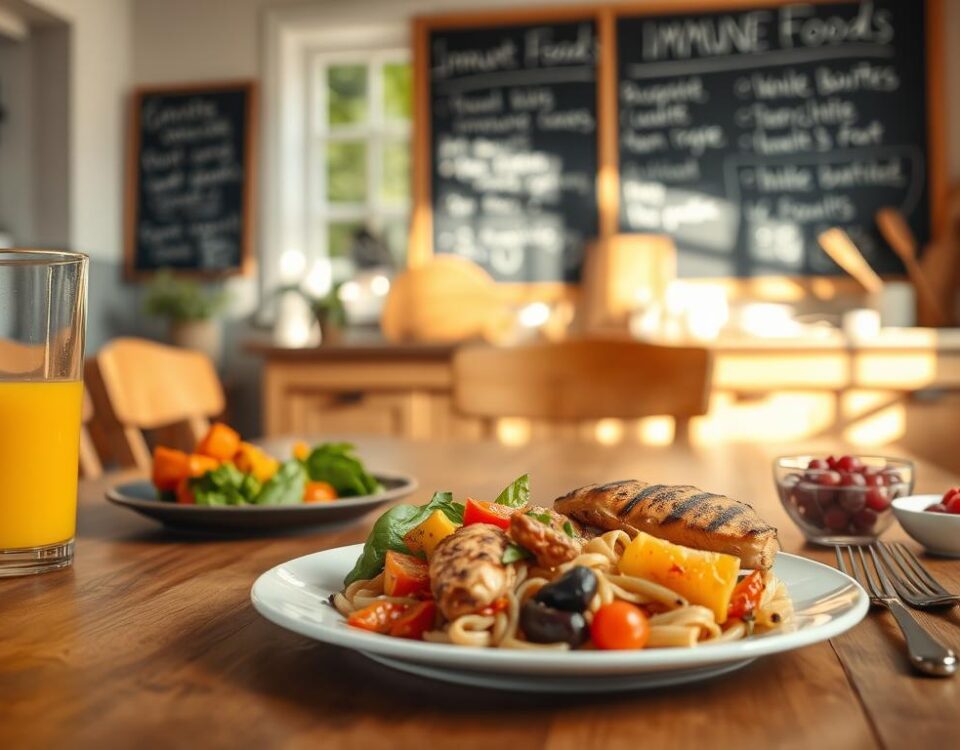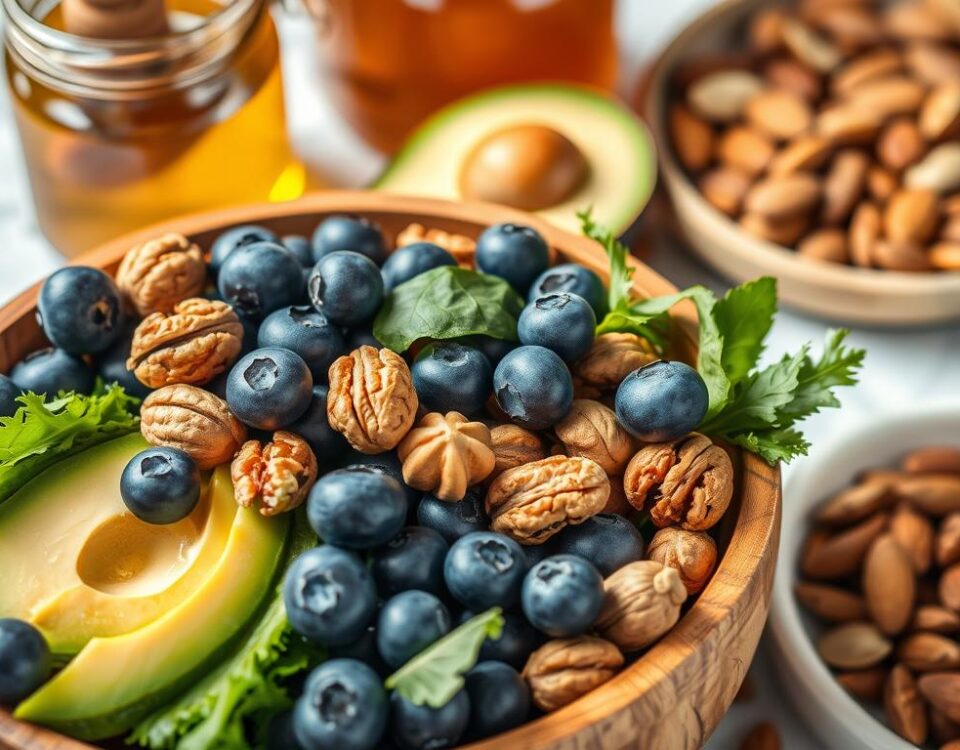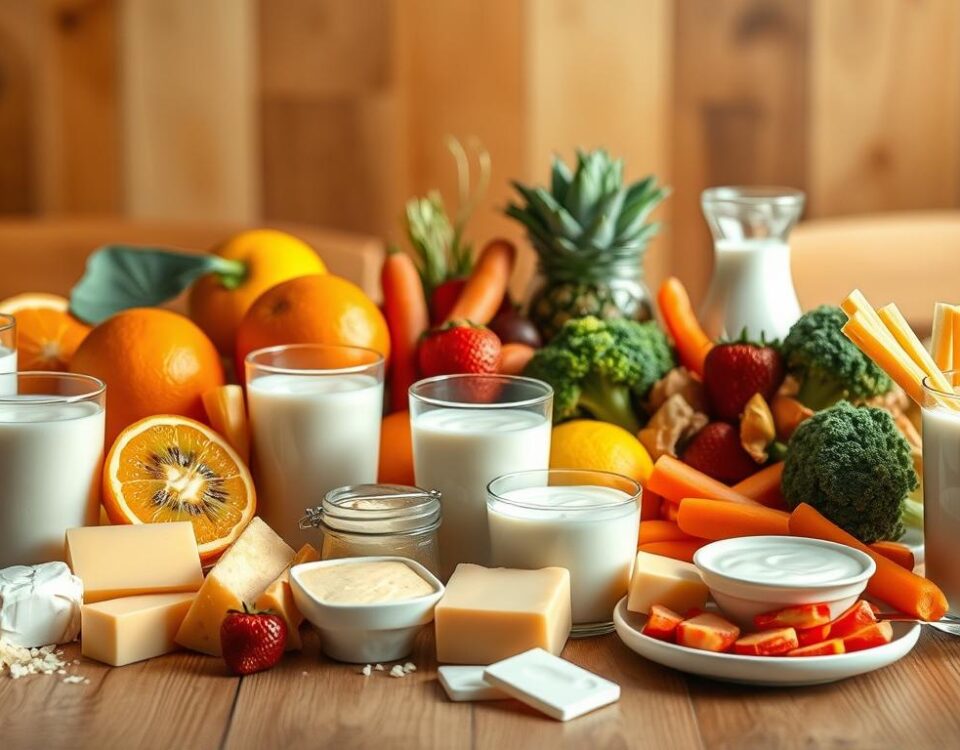
Hungarian Classics: How to Make the Perfect Goulash
May 1, 2025
The Best of Indonesian Cuisine: Satay, Nasi Goreng, and Sambal
May 1, 2025I’ll never forget the first time I tasted real Swedish meatballs at a friend’s countryside home. The warmth of dill-spiced cream sauce, the earthy tang of lingonberries, and the way every bite felt like a hug from generations past—it wasn’t just a meal. It was a story.
That experience sparked my curiosity about how humble ingredients like rye, pickled herring, and cardamom buns became symbols of a nation’s identity. What makes these dishes endure? The answer lies in traditions shaped by harsh winters, Viking ingenuity, and a love for gathering around shared plates.
Take fika, for example. More than a coffee break, it’s a daily ritual celebrating connection. My friend’s grandmother once told me, “We don’t rush fika—we savor it.” That philosophy threads through everything from smoky gravlax cured with beetroot to crispbread topped with sharp Västerbotten cheese.
Key Takeaways
- Rooted in Viking-era preservation methods like salting and fermenting
- Iconic dishes reflect seasonal ingredients and communal values
- Fika (coffee ritual) emphasizes slowing down and enjoying company
- Modern chefs reinterpret classics while honoring heritage
- Local produce like berries and dairy remains central to recipes
Introduction to Swedish Culinary Traditions
My hands still remember the rhythm of rolling köttbullar with my Stockholm host family. Their kitchen smelled of nutmeg and memories, where every folded meatball carried stories older than their blue-and-white china. That summer taught me how meals here aren’t just eaten—they’re inherited.
Seasons Shaped the Story
This country’s dishes mirror its dramatic weather. Harsh winters demanded clever preservation. Vikings salted fish to survive dark months, while summer’s brief abundance inspired berry jams still topping pancakes today. Each bite feels like a conversation between past and present.
From Survival to Celebration
What began as necessity became art. Southern bakeries transformed dense rye into fluffy cardamom buns when wheat arrived. The table below shows how key methods evolved:
| Period | Innovation | Modern Legacy |
|---|---|---|
| Viking Era | Fermented herring | Pickled delicacies at midsummer |
| 18th Century | Potato cultivation | Potato pancakes (raggmunk) |
| Early 1900s | Electric refrigeration | Fresh dairy in princess cakes |
These traditions aren’t museum pieces. Last Christmas, I watched a chef reinvent julbord smorgasbord using edible moss. Yet the soul remains—the same careful hands that once buried turnips for winter now craft Michelin-starred magic.
Discovering Swedish Food Culture Staples
The crunch of knäckebröd under my knife revealed more than crispbread—it unveiled a blueprint for survival. During a farm stay near Gothenburg, my host explained how these rye rounds kept sailors nourished for months. “Staples aren’t just ingredients,” she said, brushing flour from her apron. “They’re edible history.”

Key Dishes and Ingredients
Three elements define iconic recipes here: resilience, simplicity, and locality. Cloudberry jam sweetens pancakes because these golden berries thrive in northern bogs. Pickled herring persists not just for taste, but because ancestors needed to preserve summer’s catch. Even today, you’ll find:
| Ingredient | Role | Modern Use |
|---|---|---|
| Dill | Ancient preservative | Enhances gravlax and sauces |
| Potatoes | 18th-century staple crop | Base for creamy Janssons frestelse |
| Lingonberries | Vitamin-rich winter source | Paired with meatballs or cheese |
Understanding What Makes a Staple
A Stockholm chef once told me, “Our pantry whispers what the land allows.” Harsh climates meant every ingredient had to multitask. Barley became bread and beer. Milk transformed into aged cheeses and tangy filmjölk. This practicality birthed dishes that still satisfy modern palates.
What keeps these traditions alive? Familiarity meets flexibility. Grandmothers teach kids to roll meatballs, while restaurants stuff them with moose meat. Crispbread gets topped with avocado now, but the base remains unchanged—proof that true staples adapt without losing their roots.
Classic Swedish Meatballs & Hearty Dishes
The aroma of sizzling butter and allspice stopped me mid-sentence during a Stockholm cooking class. Our instructor grinned as she flipped golden-brown spheres in the pan. “These aren’t just meatballs,” she said. “They’re edible diplomacy.”
The Origins of Swedish Meatballs
That lesson revealed how King Charles XII brought the concept from Turkey in the 1700s. Locals adapted it using pork-beef blends and creamy gravy. Lingonberries entered the picture later, balancing richness with tartness. What began as royal fare became everyday magic—a dish equally at home in castles and farm kitchens.
My grandmother’s handwritten recipe card tells the same story. Her notes specify “equal parts tenderness and patience,” a rule I’ve tested through countless batches. The secret? Soaking breadcrumbs in milk first. This trick keeps the meat juicy, just like generations before us discovered.
Comfort Food Recipes Passed Down Through Generations
These spheres shine brightest beside buttery potatoes and tangy lingon jam. During dark winters, families gather around steaming plates. I’ve shared this meal with fishermen in Gothenburg and artists in Malmö. Each time, the combo of soft meatballs, starchy comfort, and fruity brightness feels like coming home.
Modern chefs play with venison or reindeer blends, but the soul remains. As my Stockholm friend jokes: “We Swedes don’t reinvent the wheel—we just make it roll smoother.” Whether served at Ikea or Michelin spots, swedish meatballs still spark joy. They’re proof that great ideas, like good recipes, only get better with time.
Embracing Fika: The Swedish Coffee Break Tradition
The rhythmic clink of porcelain against saucers became my afternoon soundtrack in Malmö. Fika isn’t scheduled—it happens naturally, like sunlight breaking through clouds. Locals pause work, pull up chairs, and share stories over steaming mugs. This is where connections simmer slower than the coffee brews.
Traditional Treats and Rituals
My first proper fika involved a cardamom-scented kitchen and a grandmother’s knowing smile. She arranged kanelbullar (cinnamon buns) on floral china, their swirls glistening with pearl sugar. “We bake joy into every layer,” she said, brushing crumbs from her apron. The ritual follows simple rules:
- Always serve something homemade
- Pair dark roast with sweet contrasts
- Conversation matters more than caffeine
The Iconic Cinnamon Buns and Beyond
While cinnamon stars in most bakeries, creative twists abound. A Stockholm café once served me saffron buns drizzled with cloudberry cream. The table below shows how classics evolve:
| Treat | Key Ingredients | Occasion |
|---|---|---|
| Kanelbulle | Cinnamon, sugar, cardamom | Daily fika |
| Prinsesstårta | Sponge cake, jam, whipped cream | Birthdays |
| Semla | Almond paste, milk bread | Lent celebrations |
What makes these treats magical? Balance. Tart lingonberry jam cuts through rich creams. Crunchy sugar crystals top pillowy dough. Each bite invites you to linger—because fika’s secret ingredient isn’t spice, but time.
The Allure of Pickled Herring and Preserved Foods
Silver bowls overflowing with jewel-toned herring caught my eye at a Midsummer feast near Uppsala. Each glistening piece told a story—centuries of salting, brining, and spicing to turn humble fish into edible confetti. “We don’t celebrate without these,” whispered my host, passing me a plate adorned with fresh dill sprigs.

National Celebrations and Pickled Delights
What makes this tangy treat indispensable at holidays? It’s the perfect balance of survival and celebration. Vikings buried barrels of salted herring to endure winters—today, we pile it high on Easter buffets with boiled eggs and chives. The magic lies in the marinade:
- Vinegar sharpness softened by sugar
- Crunchy onions contrasting silky fish
- Dill’s fresh bite cutting through richness
During that Midsummer meal, I learned why recipes rarely change. A grandmother demonstrated her family’s mustard-sauce version, explaining: “We tweak spices, not tradition.” Modern chefs might add horseradish or beetroot, but the base remains pickled herring—briny, sweet, and unapologetically bold.
What fascinates me most? These preservation methods outlived empires. That crisp bite of fish marinated in June sunshine tastes exactly like what a 10th-century farmer might’ve enjoyed after thawing his winter stores. Some flavors truly are timeless.
The Rich History of Scandinavian Food Preservation
The crackle of birchwood under a smokehouse first taught me about patience. Watching an artisan cure salmon near Gothenburg, I realized every wisp of smoke carried centuries of wisdom. Northern winters demanded ingenuity—turning scarcity into sustenance through methods that shaped entire communities.
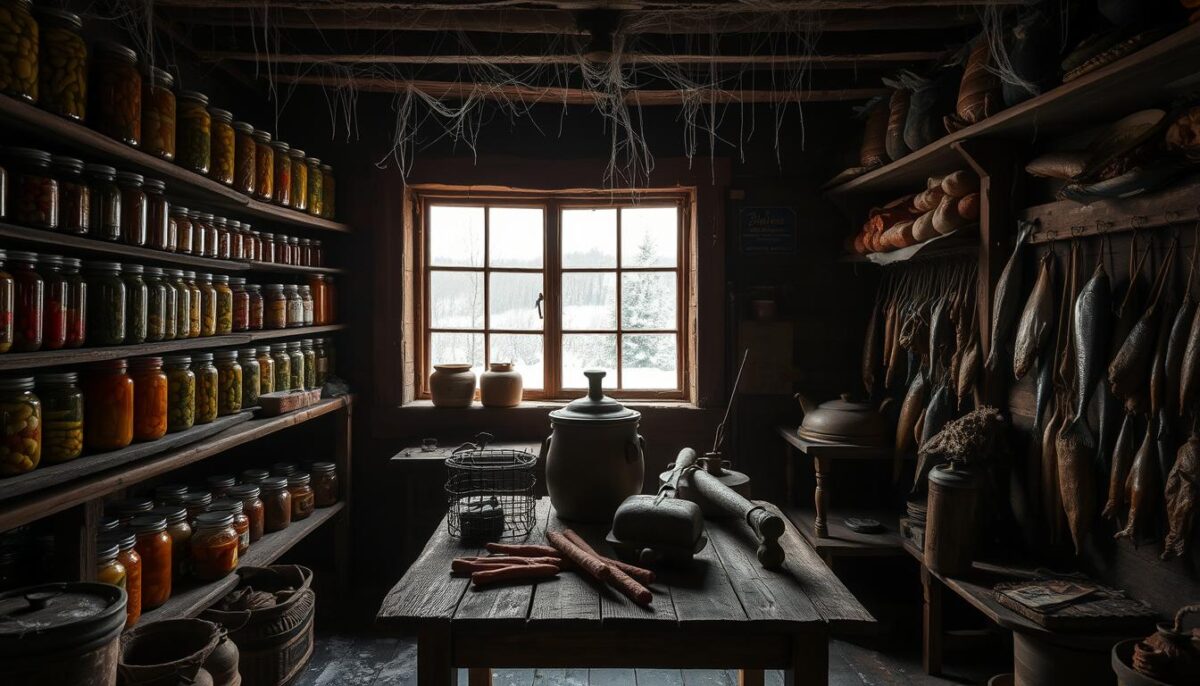
Early techniques were born from necessity. Families buried root vegetables in peat bogs, their natural refrigeration preserving harvests until spring. Fermentation transformed cabbage into tangy sauerkraut, while salting created protein-rich fish stocks. These weren’t recipes—they were lifelines.
Water mills revolutionized preservation in the 17th century. Grinding barley and rye into flour reserves allowed baking durable crispbread. Those iconic holes? Originally designed to thread strings through for storage in rafters. Every element served dual purposes.
Three pillars defined survival cuisine:
- Adaptability: Using every part of crops and catches
- Community: Shared smokehouses and root cellars
- Simplicity: Techniques requiring minimal equipment
Today, crispbread’s perforations remind me of ancestral pragmatism. What began as practical ventilation became a cultural signature. Museums display medieval baking peels beside modern crispbread packets—proof that great ideas withstand time.
Preservation wasn’t just about surviving winter. It wove families together through shared labor—children threading dried apples, grandparents monitoring brine barrels. When I bite into thinly sliced vörtbröd at Christmas, I taste more than malt and spices. I taste resilience.
Organic Farming and the Local, Sustainable Approach
Walking through a pine forest outside Örebro, I nearly tripped over a chef harvesting wild sorrel. “We don’t just cook with nature,” he laughed, brushing soil from his greens. “We let it lead.” This mindset fuels Sweden’s thriving forest-to-table movement, where chefs and home cooks source ingredients steps from their kitchens.
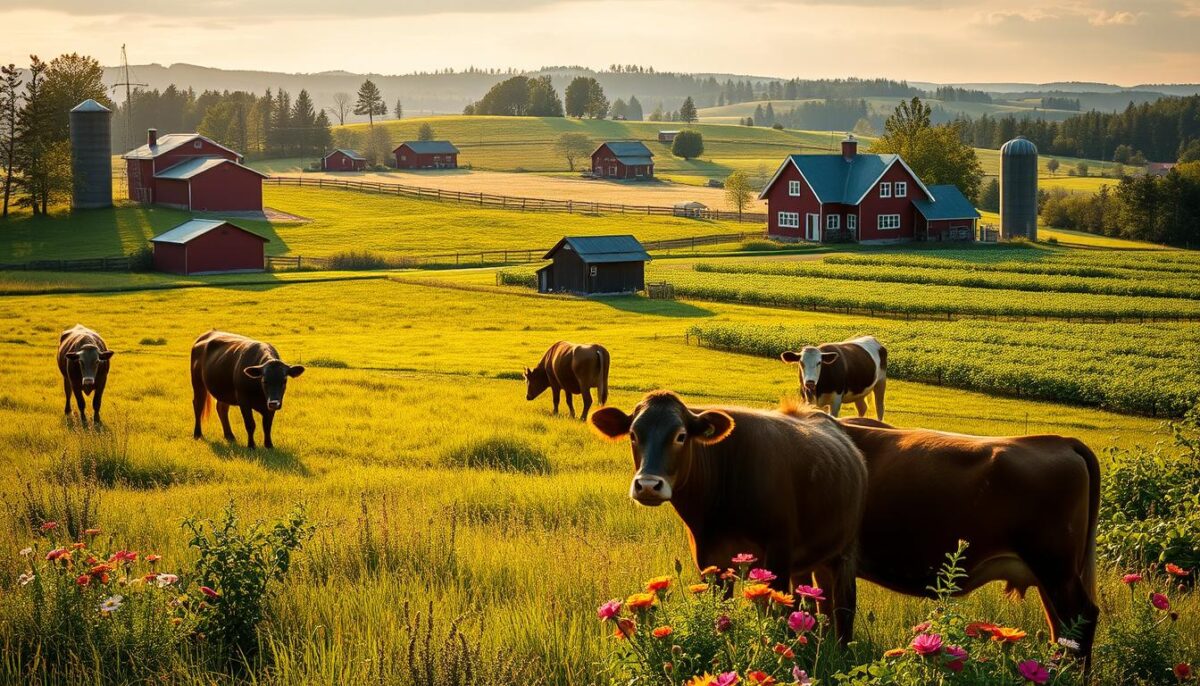
The Forest-to-Table Movement
Foraging isn’t new here—it’s revival. Families still gather cloudberries in August and hunt chanterelles after autumn rains. Modern kitchens now pair these treasures with organic vegetables from nearby farms. A Malmö restaurant owner showed me their seasonal menu:
| Ingredient | Source | Dish |
|---|---|---|
| Wild garlic | Local woodland | Pesto for potato flatbread |
| Sea buckthorn | Coastal shrubs | Dessert glaze |
| Beetroot | Urban rooftop garden | Fermented side dish |
This approach cuts food miles while celebrating regional flavors. Even humble potatoes gain new life when roasted with pine-infused salt.
Ethical Practices in Modern Swedish Kitchens
Stockholm’s restaurants now measure success by waste reduction. I watched cooks turn carrot tops into pesto and fish bones into broth. “Our grandparents wasted nothing,” explained a chef stirring juniper-smoked cream sauce. “We’re just updating their playbook.”
Community-supported farms thrive here. Members receive weekly boxes of vegetables, often planted and picked by neighbors. These initiatives feed people while keeping traditions alive—proof that caring for the land and community still shapes what’s on our plates.
International Influences on Swedish Cuisine
The first time I bit into a cloudberry-glazed brie tart at a Stockholm restaurant, I tasted two continents in one forkful. France’s creamy cheese met Arctic berries in a flaky crust—proof that Sweden’s culinary scene thrives on creative collisions. Global flavors now dance with traditional techniques, creating dishes that honor history while embracing curiosity.
French techniques left the deepest mark. A Malmö chef showed me how béarnaise sauce elevates pan-fried perch. “We swapped butter for cultured cream,” he explained. “Same richness, local twist.” Turkish spices transformed too—cardamom joined cinnamon in semlor buns, while Italian pasta shapes became vessels for dill-infused salmon roe.
Modern menus reveal fascinating fusions:
| Inspiration | Local Adaptation | Key Ingredient |
|---|---|---|
| Turkish | Meatballs with lingonberry glaze | Caramelized onion |
| Italian | Rye flour pappardelle | Smoked Västerbotten cheese |
| Japanese | Pickled herring nigiri | Sea buckthorn jam |
What excites me most? Seeing chefs balance innovation with respect. At a Gothenburg bistro, I savored saffron sugar dusted on miso-cured trout. The waiter grinned: “We don’t copy—we collaborate with tradition.”
This cultural exchange feels natural here. After all, Sweden’s cuisine has always adapted to new ideas while keeping its soul intact. Each fusion dish becomes a delicious dialogue between “then” and “now.”
Swedish Seafood Delicacies: Gravlax to Surströmming
Salt-kissed air and the sharp scent of dill greeted me at a coastal smokehouse near Helsingborg. Inside, a fisherman showed me how to layer salmon fillets with sugar, salt, and crushed juniper berries. “This isn’t just curing,” he said, patting the ruby-red flesh. “It’s time travel.”
Curing Techniques and Regional Favorites
That lesson revealed why gravlax remains a crown jewel. Originally buried in sand by medieval fishermen, today’s versions use beetroot or aquavit for color. Regional twists abound:
| Dish | Method | Signature Twist |
|---|---|---|
| West Coast Gravlax | Dry-cured 3 days | Mustard-dill crust |
| Stockholm Style | Liquid brine | Absolut vodka infusion |
Summer brings crayfish parties, where lakeside tables groan under mountains of boiled crustaceans. Locals wear bibs and paper crowns, cracking shells to the tune of schnapps songs. “We wait all year for this,” laughed my host, handing me a claw cracker.
The Surprising Pungency of Fermented Herring
Then there’s surströmming. My first encounter with this fermented fish happened in a Uppsala backyard. The tin hissed like an angry cat when opened, releasing an aroma that made my eyes water. Yet locals devoured it on crispbread with boiled vegetables, grinning at my hesitation.
Why endure the stench? Tradition. Families have buried Baltic herring in barrels since the 16th century, letting salt and time work magic. Modern food scientists measure its pH levels, but enthusiasts care more about shared laughter around stinky tins.
From silky salmon to pungent surprises, these dishes prove seafood here isn’t just eaten—it’s experienced. Each bite carries the tang of sea winds and generations who turned preservation into art.
Savory and Sweet: Swedish Desserts and Pastries
The golden glow of candlelight danced across saffron buns during my first Saint Lucia celebration in Lund. A choir’s voices mingled with the scent of cardamom as we bit into treats that tasted like edible sunshine. Here, desserts aren’t just endings to meals—they’re chapters in a sugary storybook.
Classic Princess Cake and Saffron Buns
Princess cake taught me the power of layers. At a Gothenburg bakery, I watched a chef assemble its domed beauty: vanilla sponge, raspberry jam, custard, and whipped cream, all wrapped in mint-green marzipan. “Each tier represents a different skill,” she explained, dusting powdered sugar like winter’s first frost.
Saffron buns tell a brighter tale. Linked to Saint Lucia Day, their golden hue comes from precious threads once worth more than gold. My neighbor’s recipe uses hand-ground saffron soaked in warm milk—a trick her grandmother learned from Italian traders.
| Dessert | Key Components | Occasion |
|---|---|---|
| Princess Cake | Sponge, custard, marzipan | Birthdays |
| Saffron Buns | Saffron, raisins, pearl sugar | Winter festivals |
| Lingonberry Pancakes | Berries, flour, eggs | Sunday brunch |
Seasonal Variations in Swedish Sweets
Summer transforms desserts entirely. Cloudberries replace lingonberries in jam-filled tarts, while elderflower cordial sweetens meringues. At a Midsummer feast, I tasted rhubarb crumble topped with vanilla cream—a tart contrast to smoky grilled meats.
Even pancakes adapt. Autumn versions feature apple-cinnamon compote, while spring brings birch sap syrup. Through every shift, balance remains key. As my Malmö friend says: “We want each bite to surprise and comfort—like finding mittens in a snowstorm.”
Modern Takes on Traditional Husmanskost
A chef in Gothenburg once handed me a spoonful of pea soup that tasted like childhood memories—but with smoked paprika whispering secrets. Modern kitchens now treat husmanskost (homestyle fare) as living history, blending ancestral flavors with eco-conscious creativity.
Zero-Waste Cooking and Innovative Recipes
That same soup taught me about resourcefulness. Instead of discarding pea pods, chefs simmer them into broth. Potato peels become crispy garnishes, while stale bread thickens creamy sauces. “Our grandmothers would’ve done this,” said the cook, stirring a pot of yellow split pea soup brightened with pickled carrot tops.
Even classic potato pancakes get upgrades. I’ve tasted versions using 100% of the spud—skins included—paired with lingonberry-infused sour cream. Restaurants track scraps like accountants, transforming onion ends into kimchi and herb stems into pesto.
Contemporary Twists on Comfort Food Classics
Modern plating elevates humble dishes. At a Malmö bistro, pea soup arrives in handmade clay bowls with edible flowers. Traditional meat stews get depth from mushroom powder instead of salt, while cream sauces gain silkiness from aquafaba (chickpea water).
The table below shows clever reinventions:
| Classic Dish | Modern Twist | Key Change |
|---|---|---|
| Ärtsoppa | Smoked pea soup | Applewood-infused broth |
| Raggmunk | Rainbow potato stack | Beetroot-dyed layers |
| Våfflor | Savory waffle bites | Topped with trout roe |
What excites me most? Seeing chefs honor tradition while pushing boundaries. Last week, I tried cloudberry cream piped into eggshell cups—a playful nod to resourcefulness. These innovations prove comfort food can nourish both soul and planet.
Experiencing Regional Variations and Seasonal Menus
A burst of dill and smoked fish snapped me to attention at a lakeside feast near Kiruna. Locals passed plates of golden crispbread piled with Arctic char, their laughter echoing across the water. This wasn’t just a meal—it was a geography lesson served on birchwood platters.
Seasonal shifts rewrite menus here. Summer transforms southern coasts into crayfish party hubs, while northern valleys celebrate cloudberry harvests. I’ve peeled spiced crustaceans under midnight sun and stirred wild pea soups in snow-dusted cabins—each dish tied to nature’s clock.
Northern vs. Southern Flavors
Up north, ingredients battle frost. Reindeer stew simmers with juniper, and lingonberries cut through rich game meats. Down south, creamier traditions thrive. A Malmö chef once told me, “We borrow butter from the Danes and cheese from the cows.” Their smoked herring comes draped in crème fraîche, not the sharp mustard sauces of Stockholm.
| Region | Signature Dish | Key Twist |
|---|---|---|
| North | Smoked reindeer | Cloudberry glaze |
| South | Potato gratin | Caramelized onions |
| West Coast | Boiled crayfish | Dill-crown garnish |
What unites the country? Shared joy in fleeting seasons. Families pickle vegetables in August for winter smorgasbords, and pea-based stews warm both mountain huts and city flats. At a Luleå market, I tasted rye crispbread topped with reindeer pâté—proof that distance fades when flavors speak.
Conclusion
Savoring a forkful of beet-cured salmon under midnight sunlight, I realized how every dish here whispers stories of resilience. From Viking-era fermentation to zero-waste kitchens, these traditions thrive through balance—honoring roots while embracing change.
Preserved herring taught me the power of necessity. Dill-infused gravlax and lingonberry-glazed meats reveal how simple ingredients become cultural cornerstones. What began as survival tactics now fuel Michelin-starred creativity, proving innovation grows best in fertile soil of tradition.
My pantry now stocks cloudberry jam and crispbread, small acts of keeping heritage alive. Each meal connects me to those who once buried potatoes for winter or layered marzipan on princess cakes. These flavors aren’t just meals—they’re living heirlooms.
I invite you to taste beyond the plate. Whether recreating century-old recipes or discovering modern twists, every bite celebrates a culture that turns humble ingredients into art. Because here, even a coffee break carries the weight of history—and the promise of new connections.
FAQ
Why are cinnamon buns so important during fika?
I’ve always loved how they symbolize warmth and connection. Freshly baked with cardamom and sugar, they’re a comforting anchor to slow down, chat, and savor the moment—whether at home or a café.
Are meatballs really a national dish?
Absolutely! My grandmother’s recipe—with creamy gravy, lingonberry jam, and dill potatoes—shows why they’re beloved. Though inspired by global influences, they’ve become a timeless part of gatherings and holiday tables here.
How do preservation techniques shape traditional flavors?
Pickling and fermenting, like with herring or crispbread, stem from harsh winters. I’ve tried making lingonberry preserves myself—they add tangy sweetness to dishes while honoring resourcefulness from centuries past.
What’s the story behind surströmming?
Oh, that pungent fermented herring! It’s polarizing, but I admire its cultural grit. Originally a survival food, it’s now a daring rite of passage at late-summer festivals, often paired with flatbread and onions.
How does organic farming impact modern meals?
From foraging mushrooms to using rye flour, there’s pride in local, ethical sourcing. I’ve visited farms where seasonal veggies and pasture-raised meats shine in dishes, blending tradition with eco-conscious values.
Do regional differences affect menus?
Definitely! Up north, reindeer and cloudberries dominate. In the south, dairy and apples take center stage. I’ve noticed even pea soup varies—some add mustard, others thyme—making each bite a geography lesson.

